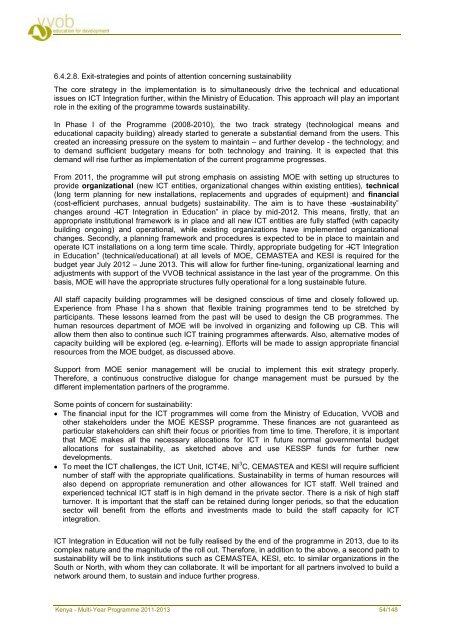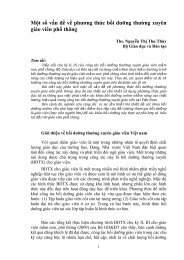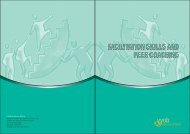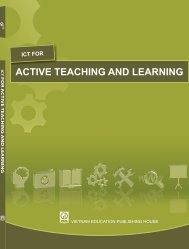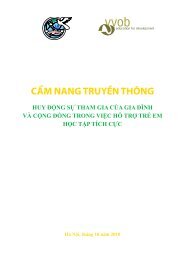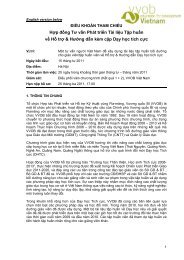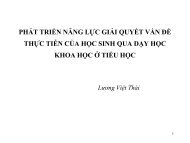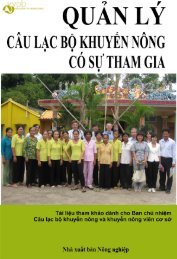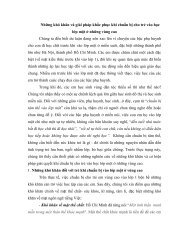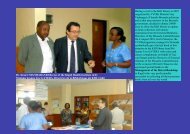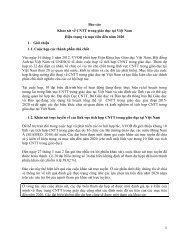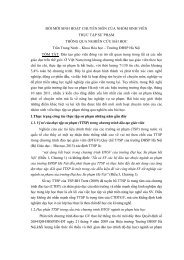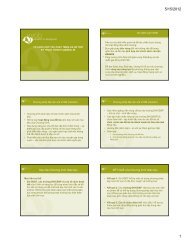Kenya Multi-Year Programme 2011-2013 - VVOB
Kenya Multi-Year Programme 2011-2013 - VVOB
Kenya Multi-Year Programme 2011-2013 - VVOB
- No tags were found...
Create successful ePaper yourself
Turn your PDF publications into a flip-book with our unique Google optimized e-Paper software.
6.4.2.8. Exit-strategies and points of attention concerning sustainabilityThe core strategy in the implementation is to simultaneously drive the technical and educationalissues on ICT Integration further, within the Ministry of Education. This approach will play an importantrole in the exiting of the programme towards sustainability.In Phase I of the <strong>Programme</strong> (2008-2010), the two track strategy (technological means andeducational capacity building) already started to generate a substantial demand from the users. Thiscreated an increasing pressure on the system to maintain – and further develop - the technology; andto demand sufficient budgetary means for both technology and training. It is expected that thisdemand will rise further as implementation of the current programme progresses.From <strong>2011</strong>, the programme will put strong emphasis on assisting MOE with setting up structures toprovide organizational (new ICT entities, organizational changes within existing entities), technical(long term planning for new installations, replacements and upgrades of equipment) and financial(cost-efficient purchases, annual budgets) sustainability. The aim is to have these ―sustainability‖changes around ―ICT Integration in Education‖ in place by mid-2012. This means, firstly, that anappropriate institutional framework is in place and all new ICT entities are fully staffed (with capacitybuilding ongoing) and operational, while existing organizations have implemented organizationalchanges. Secondly, a planning framework and procedures is expected to be in place to maintain andoperate ICT installations on a long term time scale. Thirdly, appropriate budgeting for ―ICT Integrationin Education‖ (technical/educational) at all levels of MOE, CEMASTEA and KESI is required for thebudget year July 2012 – June <strong>2013</strong>. This will allow for further fine-tuning, organizational learning andadjustments with support of the <strong>VVOB</strong> technical assistance in the last year of the programme. On thisbasis, MOE will have the appropriate structures fully operational for a long sustainable future.All staff capacity building programmes will be designed conscious of time and closely followed up.Experience from Phase I ha s shown that flexible training programmes tend to be stretched byparticipants. These lessons learned from the past will be used to design the CB programmes. Thehuman resources department of MOE will be involved in organizing and following up CB. This willallow them then also to continue such ICT training programmes afterwards. Also, alternative modes ofcapacity building will be explored (eg. e-learning). Efforts will be made to assign appropriate financialresources from the MOE budget, as discussed above.Support from MOE senior management will be crucial to implement this exit strategy properly.Therefore, a continuous constructive dialogue for change management must be pursued by thedifferent implementation partners of the programme.Some points of concern for sustainability:The financial input for the ICT programmes will come from the Ministry of Education, <strong>VVOB</strong> andother stakeholders under the MOE KESSP programme. These finances are not guaranteed asparticular stakeholders can shift their focus or priorities from time to time. Therefore, it is importantthat MOE makes all the necessary allocations for ICT in future normal governmental budgetallocations for sustainability, as sketched above and use KESSP funds for further newdevelopments.To meet the ICT challenges, the ICT Unit, ICT4E, NI 3 C, CEMASTEA and KESI will require sufficientnumber of staff with the appropriate qualifications. Sustainability in terms of human resources willalso depend on appropriate remuneration and other allowances for ICT staff. Well trained andexperienced technical ICT staff is in high demand in the private sector. There is a risk of high staffturnover. It is important that the staff can be retained during longer periods, so that the educationsector will benefit from the efforts and investments made to build the staff capacity for ICTintegration.ICT Integration in Education will not be fully realised by the end of the programme in <strong>2013</strong>, due to itscomplex nature and the magnitude of the roll out. Therefore, in addition to the above, a second path tosustainability will be to link institutions such as CEMASTEA, KESI, etc. to similar organizations in theSouth or North, with whom they can collaborate. It will be important for all partners involved to build anetwork around them, to sustain and induce further progress.<strong>Kenya</strong> - <strong>Multi</strong>-<strong>Year</strong> <strong>Programme</strong> <strong>2011</strong>-<strong>2013</strong> 54/148


